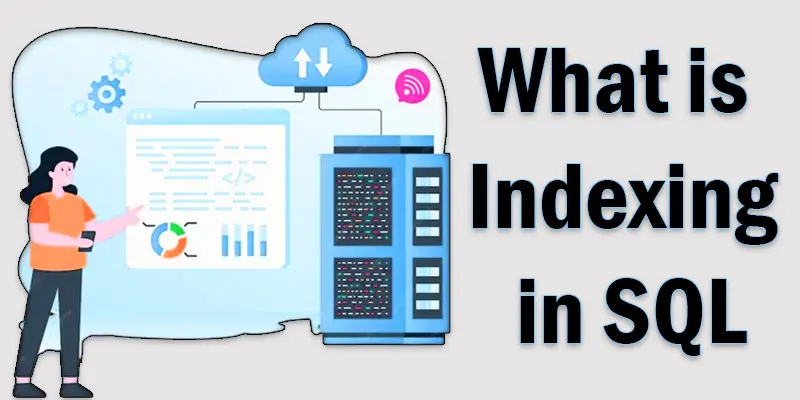How Indexing Works in SQL Databases with Examples
Published: 14 May 2025
Indexing Database SQL
It may surprise you to learn that indexing in SQL databases can increase query speed by as much as 100 times. Yet, many beginners struggle to understand how it works. Have you ever wondered why your SQL queries take too long to fetch results? This happens when databases scan entire tables instead of using an index. Slow database performance can be frustrating, especially when dealing with large datasets. Imagine searching for a name in a phone book without an index—it would take forever! That’s exactly why SQL indexing is so important. Let’s explore how it works and why it matters.
What is a SQL index
In SQL, an index is a database structure that speeds up data retrieval, therefore improving query performance. It allows the database to swiftly locate specific records without having to search through the entire table, much like a table of contents. With only a slight effect on write operations, column-based indexes speed up SELECT queries.

Types of Indexes in SQL (With Examples)
By enabling the database to find records rapidly, SQL indexes aid in accelerating data retrieval.
The main index
When a main key is linked to a column, a primary index is generated automatically. It guarantees that every record in the table is distinct and in the correct order. Example: In a Students table, the Student_ID column has a primary index to quickly locate students.
Unique Index
No two rows will have the same value in the indexed column thanks to a unique index. Data integrity can be enforced with its help. Example: In a Users table, an index on the Email column prevents duplicate emails.
Index Clustering
A clustered index defines the physical order of data in a table, ensuring it is stored in a structured sequence. Since a table’s data can follow only one order, it can have only one clustered index. Example:In an Employees table, indexing the Employee_ID column arranges records in ascending order for faster searches.
Index Without Highlights
By keeping just links to the actual data, a non-clustered index establishes a distinct structure from the main table. A table may include more than one non-clustered index. Example: In a Products table, indexing the Product_Name column allows faster searches without changing the data’s physical order.
Complete-Text Index
Large text-based material, such articles or descriptions, can be efficiently searched with a full-text index. Example: In a Blog table, indexing the Content column helps search for specific words in articles.
Composite Index
A composite index is formed on many columns to improve searches involving various conditions. Example: In a Customers table, an index on First_Name and Last_Name speeds up searches for people by full name.
How to Create and Use Indexes in SQL
By enabling the database to locate records rapidly rather than going through the full table, SQL indexes help speed up searches.
Creating an Index
The construct INDEX statement is used to construct an index on a column. As a result, queries based on that column execute better. For instance, if you regularly look up clients by name, indexing the Name column speeds up retrieval.
Creating a Unique Index
A unique index ensures that no duplicate values exist in a column. It is useful for fields like email or username. Example: If a users table requires unique emails, an index prevents duplicate entries.
Creating a Composite Index
A composite index is used when queries filter by multiple columns. It improves performance when searching using both columns together. Example: If customer searches are often based on First Name and Last Name, creating an index on both makes queries faster.
Using Indexes for Faster Queries
Once an index is created, SQL automatically uses it to speed up SELECT queries. However, indexes do not improve INSERT, UPDATE, or DELETE operations and can sometimes slow them down.
Checking Existing Indexes
To see what indexes exist in a table, use a command like SHOW INDEX in MySQL or sys.indexes in SQL Server.
Removing an Index
If an index is no longer needed or slows down operations, it can be removed using the DROP INDEX command.

Pros and Cons of Using Indexes in SQL
Indexes help speed up database queries, but they also have drawbacks.
Pros of Using Indexes
Faster Data Retrieval
- Indexes make searches much quicker, reducing the time needed to find records.
- Useful when working with large tables.
Efficient Sorting and Filtering
- Indexes help with ORDER BY and WHERE clauses, making sorting and filtering faster.
- Saves processing time for queries.
Improves Join Performance
- When combining tables using JOIN, indexes help locate matching records quickly.
Reduces Full Table Scans
- Without indexes, the database scans the entire table for every query, which slows down performance.
Ensures Uniqueness
- Unique indexes prevent duplicate values in key columns like email or ID numbers.
Cons of Using Indexes
Slows Down Write Operations
- NSERT, UPDATE, and DELETE operations take longer because the index needs to be updated every time data changes.
Consumes Extra Storage
- Each index takes up additional disk space, especially for large databases with multiple indexes.
Overhead in Maintenance
- The database must update indexes whenever data changes, adding extra processing time.
Not Always Helpful
- Indexes improve SELECT queries but do not help every type of query.
- If used incorrectly, they may even slow down performance.
Too Many Indexes Can Hurt Performance
- Adding too many indexes increases storage use and slows down write operations.
- Choosing the right indexes is important for balanced performance.
Best Practices for Indexing in SQL
Indexing can improve query performance, but if used incorrectly, it can slow down your database.
Index the Right Columns
- Pay attention to the columns that are used in the ORDER BY, JOIN, and WHERE clauses.
- Avoid indexing columns that are rarely used in queries.
Use a Primary Key for Automatic Indexing
- A Clustered Index is automatically created by a Primary Key, effectively organizing data.
- Always define a Primary Key in your table for better performance.
Keep Indexes Minimal
- INSERT, UPDATE, and DELETE operations are slowed down by an excessive number of indexes.
- Make only the indexes required for query optimization.
Use Composite Indexes Wisely
- If a query frequently searches using multiple columns, create a composite index.
- Example: If users often search for First Name + Last Name, index both together instead of separately.
Avoid Indexing Small Tables
- Indexes help with large tables, but for small tables, scanning the entire table is often faster.
- Avoid unnecessary indexing on small datasets.
Regularly Monitor and Maintain Indexes
- Remove unused indexes that take up storage but don’t improve performance.
Use Full-Text Indexing for Large Text Searches
- If searching within large text fields (like article content or comments), use a Full-Text Index instead of a normal index.
- It improves text search efficiency and reduces query time.
Avoid Indexing High-Update Columns
- Columns that change frequently (like timestamps or counters) should not have indexes.
- Index updates slow down write operations.
Consider Indexing Foreign Keys
- If tables have Foreign Key relationships, indexing the foreign key columns can speed up joins and lookups.
Test Performance Regularly
- Use EXPLAIN (MySQL) or EXPLAIN ANALYZE (PostgreSQL) to see how indexes affect query execution.
- Adjust or remove indexes based on query performance results.
Real-Life Example – How Indexing Improves Performance
- Scenario: A shopping website has a Products table with millions of records.
- Without Indexing: Searching for a product by name scans the entire table, making it slow.
- With Indexing: An index on the Product_Name column helps the database quickly locate the product without scanning every row.
- Result: Search queries that took seconds now take milliseconds, improving user experience.
- Bonus: Faster searches mean happier customers and better website performance.

Conclusion About What is Indexing in SQL
We’ve covered indexing in SQL databases in detail. Indexing speeds up searches and improves performance, but using it wisely is key. I recommend indexing frequently queried columns while avoiding unnecessary indexes that slow down updates. Regularly monitor your indexes to keep your database efficient. Want to learn more? Explore advanced SQL indexing techniques and optimize your database today!
FAQS Indexing Database
The main purpose of indexing is to make queries faster by reducing search time. It helps the database locate records quickly, especially in large tables. Indexing improves performance but can slow down data insertion and updates.
A database structure that expedites data retrieval is called an index. For instance, building an index on the Email column enables the database to get results more quickly if you regularly search for clients by email. Without an index, the database scans every row, making searches slower.
Indexing in DBMS (Database Management System) is a technique to speed up queries by creating a structured way to access data. It improves efficiency by reducing search time. Indexes act like shortcuts to find the required data faster.
The construct INDEX command can be used to construct an index. An index on the LastName column is created for quicker searches, as seen in the example CREATE INDEX idx_name ON Customers (LastName).
Indexing is a method to speed up searches by creating a reference structure, while sorting arranges data in a specific order. Sorting is temporary and used within queries, whereas indexing is a permanent database feature. Indexing helps with faster lookups, but sorting is mainly for organizing output.
Database indexing works by creating a shortcut for searching data. Instead of scanning every row, the database checks the index to find data faster. This makes queries run much quicker, especially for large datasets.

- Be Respectful
- Stay Relevant
- Stay Positive
- True Feedback
- Encourage Discussion
- Avoid Spamming
- No Fake News
- Don't Copy-Paste
- No Personal Attacks

- Be Respectful
- Stay Relevant
- Stay Positive
- True Feedback
- Encourage Discussion
- Avoid Spamming
- No Fake News
- Don't Copy-Paste
- No Personal Attacks





